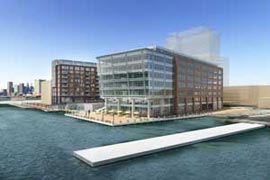History
For more than 140 years, the Mutual Chemical Company and later Allied Chemical operated a chrome processing and manufacturing facility on Baltimore's harbor, often referred to as the Baltimore Works. Chromium is used in making stainless steel and for chrome plating of other metals to reduce corrosion. It is also a component of certain ink and paint pigments. In the past it was used for leather tanning and wood preservation.
Operations at the plant ceased in 1985. A $110 million cleanup of the Baltimore Works site was completed under the supervision of the U.S. Environmental Protection Agency (EPA) in 1999. Plans for redevelopment of the site – now known as Harbor Point – have made this 27-acre parcel a national benchmark for beneficial reuse and productive redevelopment of former industrial sites. In 2003 it was cited by EPA as a model for the agency's Land Revitalization Program, which incorporates beneficial land reuse into EPA's cleanup programs.
In 2006, the site received approval from Baltimore City's Planning Commission for a comprehensive mixed-use redevelopment plan led by Struever Bros. Eccles & Rouse and H&S Properties Development Corporation. The development includes plans for two hotels, retail, residential and office space.
Chrome Ore Processing Residue or COPR (pronounced ko-per) – a byproduct of operations at the Baltimore Works plant – was used as fill material at the Dundalk Marine Terminal. Some COPR was also placed at Allied's factory on Race Street in South Baltimore. At the time, use of the material for similar applications was a commonly-accepted practice in Maryland and throughout the area.
Today, Honeywell, Allied Chemical's successor company, is a diversified global technology and manufacturing leader. In Baltimore—and in locations around the country—the company is actively addressing the environmental legacies of industrial sites owned or operated by its predecessor companies.
The company has long been a partner with the Maryland Port Administration (MPA) and the Maryland Department of the Environment (MDE) on remediation work and environmental projects at the Baltimore sites where COPR was disposed of or used as fill material. In April 2006, Honeywell entered into agreements with MPA and MDE that will expedite the development of a final remedy at the Port. In partnership with the city, we have spent more than $2 million on remediation at the Race Street site, which is owned by the city.
Honeywell is proud of its role in the cleanup of the Baltimore Works site and its continuing efforts at the Dundalk Marine Terminal and Race Street. In Baltimore, and elsewhere, we have demonstrated that by using sound remediation practices and contemporary science, sites with complex environmental histories can once again be vital parts of the community.
Honeywell's health, safety, environmental and remediation programs are described at length on our "Sustainable Opportunity" webpage, located at www.honeywell.com/sites/hser/index.html. The website highlights our commitment to managing "our businesses in ways that are sensitive to the environment, striving to meet or exceed all applicable regulatory requirements and our own extensive performance standards governing health, safety, environmental and remediation matters."


